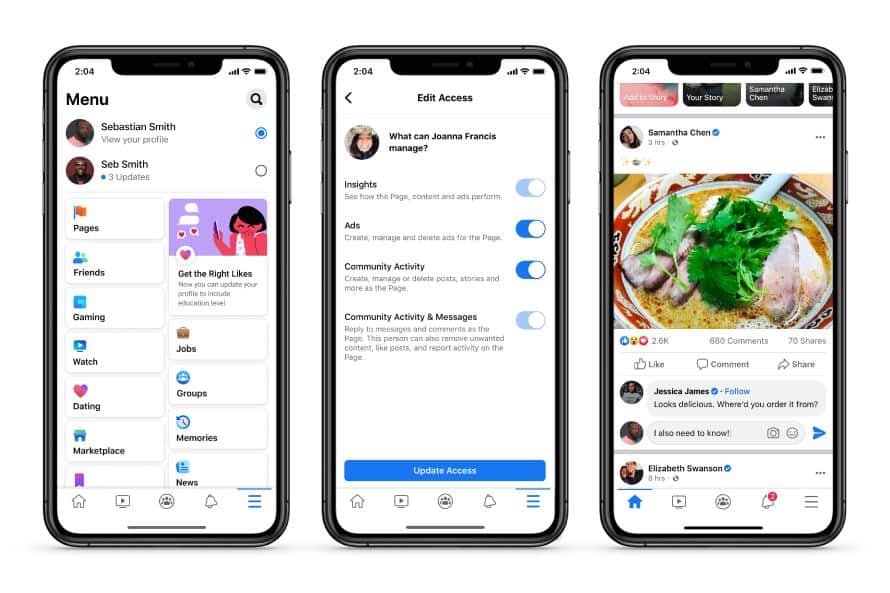Setting up a Facebook page for your business or brand is a great way to connect with your audience and expand your reach. But with over 200 million businesses using Facebook for those purposes, you have to find a way to stand out if you hope to get as many followers, shares, and likes as possible.
That is where optimization for Facebook pages comes into play, as optimizing your page for increased exposure can give you the results you desire. Here are some simple tips you can follow to achieve that goal, so you are not only more visible on Facebook itself, but also on search engines and in the search engine results pages (SERPs).
Read: Social Media Optimization Tips for Twitter.
Tips for Optimizing Facebook Pages
Below you can find some tips for optimizing Facebook pages.

Facebook Page Names
Can you change a Facebook page’s name later on if you feel like you made a mistake? Sure, but you are better off picking the right name from the start so you can get that much-needed SEO boost. To what degree search engine like Google place on social media pages is a debated topic, but the search giant itself has stated that it uses social signals for ranking purposes. For that reason, we suggest you name your Facebook page to reflect that notion.
One of the most standard search engine optimization tips is to include plenty of relevant keywords in your content. Try to do the same with your name.
Does this mean you should stuff your Facebook page’s name with keywords? Of course, not, as that will be too spammy, which can negatively impact follower engagement plus your relationship with Facebook’s algorithms.
If you can, aim for a single, long-tail keyword. The first word of your page title gets plenty of attention from Google, so try to make it count. If you are too generic with the name, you will get lumped in with all of your competitors, which will make it much harder to gain exposure.
As for some naming tactics to avoid at all costs, do not try to be edgy by lacing your name with an odd spelling, improper capitalization, or special characters. While a name like “Dav!d’$ D!amond$” may catch the eye, it won’t do much for your social media optimization goals.
Make Your URL Match
Facebook will assign you a dynamic URL that it generates automatically once you make your page. Get a vanity URL that matches your company’s name instead of sticking with what the platform gives you.
Your vanity URL should give people an idea of what your business is about. As such, make it descriptive yet concise. Doing so can improve your brand recognition and visibility, plus it can make it easier for your target audience to find you on Facebook or the Web. In short, getting a vanity URL is an easy way to get off to a solid SMO start.
For example, ditching www.facebook.com/pages/PersonalizedPillows/1329847763 for www.facebook.com/pages/PersonalizedPillows looks a lot cleaner and makes you more searchable.
Make Sure Your Business Information is Complete
Here is a solid social media optimization practice that is easy to implement, yet often overlooked. Even if you have an online business that you run from wherever you are on a particular day, make sure that your company’s name, address, and phone number are up-to-date and consistent across the Web.
By having an accurate address for your headquarters, Google can index your business for local search. But beyond that SEO boost, ensuring contact information accuracy makes it easier for prospects to get in touch with you while also adding legitimacy and trust to your name.
Do you need another reason to update your contact info? Users can check in and share that info in their status to expand your business’ reach even more.
Spend Some Time on Your About Tab
When you land on a new Facebook page that you are curious about, what do you usually do first? If you do not scroll down, you check the About tab first to learn more about the company.
Keep this in mind when creating your Facebook page, as your About tab can play a huge role in either retaining an audience or having them move on to something else.
Since you only have 155 characters to fill the About tab, make it count by summarizing your company’s primary purpose and how it can benefit customers. Do not forget to include some keywords in that description, either.
Spread Keywords Throughout Your Page
Speaking of keywords, you want to ensure they are distributed not just in your About tab or name, but also in other areas, such as the Description section, headlines, notes, photo captions, and updates.
Long-tail keywords are your best bet, as they will help visitors see relevancy while on your page. For example, use a specific keyword like “personalized pillows for dog lovers” versus “personalized pillows.”
If you are having trouble coming up with keywords to lace your page with, use SEMRush or some other keyword search tool for ideas.
Be Selective with Your Tabs
The last thing you want to do is confuse your visitors with a bloated Facebook page with tons of unnecessary tabs with content spread all over the place. To prevent his, use custom tabs to organize your page.
You can add custom tabs for Posts, Reviews, Photos, and Videos, for example, while removing ones that you will not need to eliminate clutter and navigational issues. And while this will make it easier for your audience to find desired content on your page, it will also make it easier via search engines.
Inspire Action from Your Followers
Think about the main reason why you are creating a Facebook page. Sure, you want to expand your reach and get your name out there, but more importantly, you want your audience to take some type of action.
To get that desired result, your content needs to have a call to action (CTA) that is both visible and clear. They should be able to see the CTA without having to scroll all over the place, and it should be clear as to what action you want them to perform. In doing this, you can drive substantial traffic from your Facebook page to your websites so you can get the biggest SMO boost possible.
Here is a simple formula you can follow when creating a CTA: Action word + outcome = CTA. For example, if you own a company that specializes in the keto diet and you are promoting a meal plan, your CTA could be, “Click here to start losing weight today.”
To get the most bang for your buck from a CTA, focus on how it can benefit your audience instead of just listing a feature. Even better, hit your audience’s pain points and let them know that they can solve that specific problem by clicking the CTA. “Want to fit into your favorite jeans?” could be an example.
If you need some action words so you can brainstorm different CTAs, here they are:
- Browse
- Contact
- Discover
- Download
- Find out
- Get
- Learn
- Read
- Register
- See
- Sign up
- Start
- Try
- Unlock
- Visit
- View
- Watch
Take Time When Creating Content
To optimize your Facebook page, you need to create content that is of high quality and helpful. It should be educational or entertaining, so they get the urge to bookmark it, like it, share it, comment on it, and keep coming back for more.
Besides ensuring that your content is purposeful and emphasizes quality over quantity, employ SEO practices such as these:
- Include keywords in your post descriptions.
- Make the first word a keyword to get Google’s attention.
- Google uses the first 18 characters as a meta description, so be selective.
Use Backlinks
Backlinks can play a significant role in Facebook page SMO. Your content will come off as valuable and relevant if authority sources link back to it.
One way to use backlinks to your advantage is to connect with influencers who will let you make guest posts with links to your Facebook content. This will not only make your page more popular but can also generate an increase in quality traffic. You can also put links to your Facebook page in your blog posts if you have a blog. Each time a trustworthy source shares your blog, your Facebook page will get a boost.




